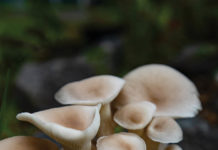Story by Shannon Wianecki | Photo courtesy of DLNR/Division of Aquatic Resources
 In the shadows below the surface of ‘Iao Stream, the ‘o‘opu nakea rests beneath a rocky overhang, its fat-lipped pout reminiscent of an English bulldog. This indigenous Hawaiian stream dweller can be as tenacious as its canine double. Not content to linger in the lower pools, it seeks the pristine eddies some thousand feet above sea level. Over millennia, evolution has fused the pelvic fins on its belly into a suction cup, which it uses to scale some of the world’s tallest waterfalls inch by inch.
In the shadows below the surface of ‘Iao Stream, the ‘o‘opu nakea rests beneath a rocky overhang, its fat-lipped pout reminiscent of an English bulldog. This indigenous Hawaiian stream dweller can be as tenacious as its canine double. Not content to linger in the lower pools, it seeks the pristine eddies some thousand feet above sea level. Over millennia, evolution has fused the pelvic fins on its belly into a suction cup, which it uses to scale some of the world’s tallest waterfalls inch by inch.
O‘opu nakea is the largest and most abundant of five native goby species; adults can surpass a foot in length and weigh half a pound. Ancient Hawaiians were fond of o’opu steamed in ti leaves—a feast reserved for royalty. Commoners who dared cook it were betrayed by the telltale aroma. The village of Waihe‘e, in Central Maui, was known for its makani kili ‘o‘opu, or ‘o‘opu-scented wind.
Like most Hawaiian stream animals, ‘o‘opu nakea are amphidromous, living part of their lives in the stream and part in the sea. They spawn year-round, peaking during rainy season. Females lay egg masses on basalt river rocks. Heavy rains wash hatchlings to the sea, where they fatten for several months on marine nutrients before returning upstream to their birth site.
Unfortunately, when Maui’s waterways were diverted to feed thirsty cane fields, aquatic animals lost their lifeline between the mountain and ocean. Juvenile fish journeying home perish in puddles and dried-up streambeds, waiting for rains big enough to overflow the manmade diversions and dams.
To get a glimpse of this increasingly rare stream inhabitant, strap on a mask next time you visit ‘Iao Valley. Peer amid the river rocks and filtered sunlight for a shy fish waving black-barred yellow fins. Few celebrated mountain climbers are as accomplished as this wee Hawaiian goby.


















